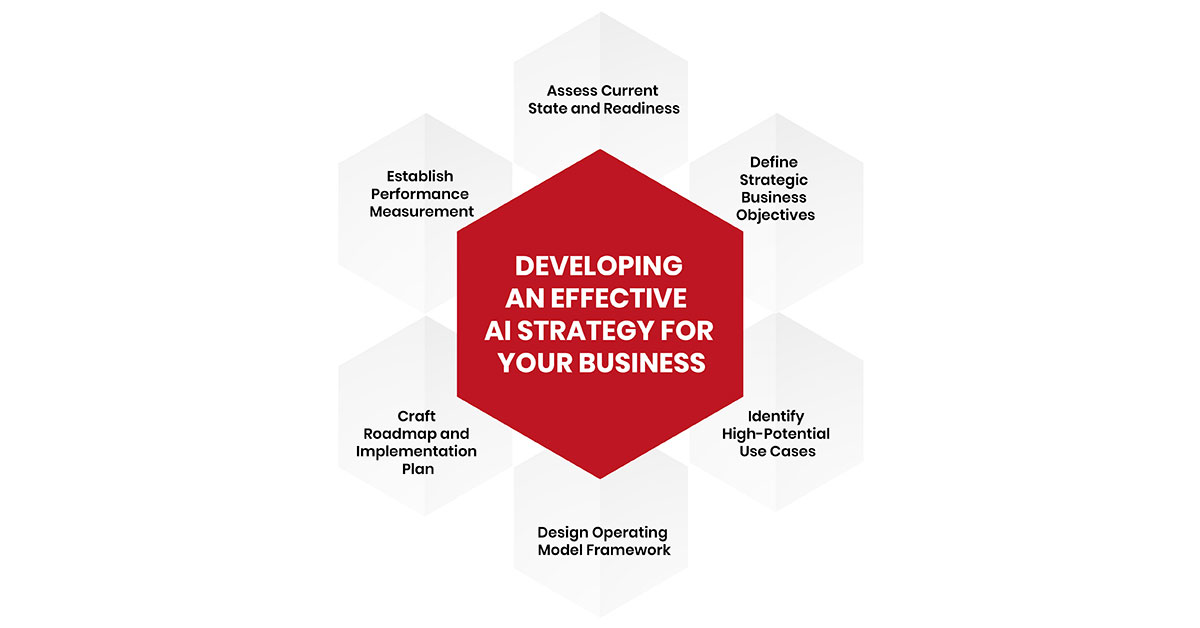Understanding AI Strategy: Key Principles for Success in Today's Digital Era
 August 06, 2024
August 06, 2024
Artificial intelligence is disrupting industries and transforming businesses at a rapid pace. As AI capabilities continue to evolve each day, forward-thinking companies are developing comprehensive AI strategies to guide their AI adoption journey and maximize the technology's potential. This article explores what an AI strategy entails, why it is essential for every organization, and how to develop an effective business strategy to stay ahead of the competition.
What is an AI Strategy?
An AI strategy is a high-level plan for integrating artificial intelligence technologies into an organization in a way that aligns with business goals and objectives. It acts as a blueprint that outlines how a company will identify AI use cases, develop relevant solutions, acquire needed skills and resources, address risks and challenges, and ultimately drive business value through AI.
Some key elements of an effective AI strategy include:
- Assessing the organization's AI readiness and identifying priority areas for AI deployment
- Defining strategic objectives and quantifiable metrics to measure AI's impact
- Developing a phased roadmap with timelines for rolling out AI initiatives
- Determining technical architecture and infrastructure requirements
- Building a Center of Excellence to oversee AI efforts
- Addressing ethical, legal, and privacy considerations
- Establishing governance guidelines for responsible and transparent AI
- Creating an adoption and change management plan
- Developing talent strategies to cultivate needed AI skills
- Allocating proper funding and executive sponsorship
The depth and detail of an AI strategy may vary depending on a company's size, industry, goals, and AI maturity. However, having a well-defined strategy is crucial to ensure AI efforts are purposeful, well-coordinated, and aligned to deliver AI in business.
Why Every Business Needs an AI Strategy
There are several compelling reasons why formulating an AI strategy should be a top priority for all organizations:
-
Provides Focus and Direction
Firstly, an AI strategy provides essential focus and direction. Without a clearly defined strategy, AI initiatives can easily lack focus and drift away from an organization's core objectives. Companies may waste resources by pursuing peripheral projects that do not align with their overall goals. A good strategy brings discipline by outlining which problem areas will provide the greatest value if addressed using AI. It helps prioritize investments and provides a roadmap to guide AI development in a cohesive manner.
-
Drives Competitive Advantage
Secondly, having a unified AI strategy is critical for gaining and maintaining competitive advantage. Pioneering companies across various industries are proactively embedding AI into their most important operational processes and customer touchpoints. This allows first-movers to optimize operations, enhance product offerings, and provide unparalleled customer experiences. Competitors struggle to catch up once the innovative firm establishes an entrenched position. A strategic approach helps businesses maximize AI's potential across their value chain and remain ahead of imitators.
-
Accelerates Value Realization
Thirdly, developing an AI strategy from the onset accelerates the realization of value from AI projects. It enables organizations to focus AI deployments on initiatives directly tied to critical business objectives and measurable Key Performance Indicators. This empirical, results-oriented mindset helps steer investments toward efforts most likely to provide a swift return. Without a strategic lens, companies risk diverting funds to experiments that may be interesting academically but have an uncertain practical impact. An outcomes-based strategy gets AI to deliver tangible benefits more quickly.
-
Reduces Wasteful Spending
Establishing an AI strategy reduces wasteful spending that often occurs in the absence of a unified vision and governance structure. Numerous departments within large enterprises independently launching AI proofs-of-concept and pilots commonly result in duplication of efforts. There is a significant risk of over-investment in speculative solutions unlikely to scale. A holistic strategy minimizes such inefficiencies by promoting coordination and optimizing budgets across an organization's AI portfolio.
-
Mitigates Project Failure Risks
Developing an AI strategy also helps mitigate risks associated with AI project failures. Without proper planning and integration of new technologies into workflows, there is considerable risk of well-funded initiatives delivering lackluster or no results. Strategic forethought is needed to avoid AI solutions becoming shiny distractions that fail to gain user adoption or yield ROI. It ensures new technologies are rolled out sustainably and integrated seamlessly into core business processes. This considerably reduces the chances of costly implementation failures.
-
Aids Talent Acquisition
Having a clearly defined AI strategy aids in attracting and retaining top talent. The explosive growth of AI has intensified global competition for data science and engineering skills. An effective strategy demonstrates a company's commitment to innovative AI work and provides clarity on the types of problems employees would solve. It positions an organization as an employer of choice for candidates seeking to apply their skills to meaningful, strategic initiatives instead of one-off projects. This strategic framing during recruiting is crucial for talent acquisition in today's tight tech labor market.
-
Preps Organization for Disruption
Developing an AI strategy also prepares the business and workforce for impending disruptions. AI is revolutionizing entire industries by automating conventional jobs and spawning new domains like machine learning engineering. A strategic approach helps educate leaders and employees on AI's far-reaching impact. It drives organizational transformation needed to adapt roles, workflows, and culture to a rapidly evolving technology landscape. Proactive re-skilling ensures the workforce remains relevant and productivity uplifts are fully leveraged.
-
Promotes Responsible Transition
Additionally, taking a strategic view promotes more responsible transitions brought on by AI adoption. Strategic planning combined with framing policies helps introduce intelligent technologies while maintaining robust oversight on ethics, privacy, explainability, and security considerations. A step-by-step roadmap guided by societal impact assessments mitigates risks of disruption and helps earn public trust essential for long-term sustainability.
-
Future Proof Investments
Finally, formulating an AI strategy future-proofs the business by incorporating the flexibility needed to respond to changing market and technology dynamics. Emerging techniques like machine teaching, blockchain integration with AI, and quantum computing will profoundly influence AI's applications in the coming years. A well-defined strategy, reviewed periodically, can pivot direction when opportunities or threats emerge on the horizon. It safeguards AI investments from obsolescence in a field advancing at an unprecedented pace.
In summary, developing a comprehensive yet adaptable AI strategy is imperative for businesses seeking to optimize value from AI and lay foundations for resilient, future-focused operating models. A lack of strategic direction can render even well-funded AI explorations ineffective and increase existential risks. A unified vision supported by cross-functional collaboration is key to maximizing AI’s widespread benefits.
Developing an Effective AI Strategy
Follow these six steps when formulating your company's AI strategy:

-
Assess Current State and Readiness
The first step is to evaluate our company's existing data assets, technology infrastructure, AI skills, and overall AI maturity to set a clear baseline. We will audit data collected from operations, products, customers, and partners to assess volume, variety, velocity, and veracity. An inventory of software, hardware, cloud resources, and network capabilities will show our technical readiness. Benchmarking these assets and capabilities against top competitors in our industry will illustrate gaps requiring attention. Reviewing positions and assessing core skill levels across data science, engineering, product, and business roles will identify future talent needs. Finally, examining past AI initiatives and quantifying impacts to date will establish our baseline AI maturity.
-
Define Strategic Business Objectives
With a grounded understanding of our current state, we can outline strategic business objectives for the next three to five years aligned with our high-level growth and market positioning goals. Top priorities may include increasing share in high-growth customer segments, optimizing supply chain operations to lower costs by 10%, or developing new data-driven product lines. We will focus initial AI initiatives on providing the most immediate market differentiation compared to competitors. Projects directly supporting these top objectives will receive priority in resource allocation.
-
Identify High-Potential Use Cases
Next, we will map our end-to-end business processes and operations to identify where AI can automate manual tasks, generate new insights from data, or enhance human decision-making. Focusing first on our core competencies and biggest pain points, we will evaluate opportunities across customer-facing, operational, and internal support functions. Each use case will receive a rapid qualitative and quantitative ROI analysis to establish potential impacts on key metrics like revenue, costs, productivity, customer satisfaction, and employee engagement. Top use cases directly furthering strategic objectives and delivering the highest value will be prioritized for rollout.
-
Design Operating Model Framework
With high-value use cases prioritized, we will design an operating model framework for incorporating AI across our organization. This includes determining the optimal organizational structure with centralized and decentralized governance and formalizing new AI-focused job roles and teams. We will also establish clear accountabilities, and allocate appropriate budgets and infrastructure resources. AI ethics will be proactively addressed upfront through policy frameworks for data privacy, security, bias, and transparency. Governance policies for change management, IP protection, and vendor partnerships will instill discipline and oversight.
-
Craft Roadmap and Implementation Plan
Pulling insights together, a phased multi-year AI roadmap will now be developed with quarterly and annual milestones. Individual work streams for priority use cases as well as foundational enablers will receive detailed planning. The initial focus on automation use cases can establish momentum and ROI while longer-term transformational efforts are prepared in parallel. The implementation approach factors change management and marketing/adoption needs through intensive employee training programs and rollout communications. Continued stakeholder engagement ensures organizational alignment as our AI strategy evolves over time.
-
Establish Performance Measurement
Lastly, we will tie specific, quantifiable KPIs linked to our strategic objectives, enabling rigorous performance tracking over phases and iterations. Qualitative measures assessing cultural shifts, employee satisfaction, and AI maturity will supplement analytics. Regular strategic reviews will quantify ROI, refine objectives in light of market evolutions, and reallocate resources as needed to maximize ongoing impacts. Performance frameworks will institutionalize an evidence-based approach rooted in measurable business value for iteratively enhancing our AI strategy.
Conclusion
Regularly communicating progress, addressing challenges encountered, and seeking executive sponsorship and stakeholder buy-in throughout development and execution are also crucial. With the right strategic approach, AI can significantly boost an organization's competitiveness in today's digital-first world.


